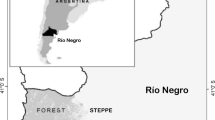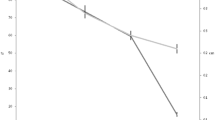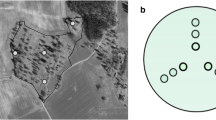Abstract
Low-input dry meadows are habitats of high nature value. More and more, less time-consuming harvesting techniques replace different steps of the traditional hay making process. The use of leaf blowers instead of rakes for hay making became popular in the last ten years in Switzerland. Thus, we set up a case study to test effects on the conservation value. The studied dry meadow of high nature value is located in the municipality of Stans (Switzerland). After five years no significant differences between blown and raked plots in species richness, richness of target an indicator species, medium plant-indicator values, i.e. nutrients, humidity, light or in the species assemblages were observed. From 2010 until 2014 the moss cover increased in all plots. The differences between raked and blown plots were not significant. In 2015, however, the difference between the two treatments increased to 13%. While the moss cover of the blown plots remained at 20%, the moss cover of the raked plots dropped to 7%. These results from only one case study and only a short observation period of five years do not allow a generalization, but they give a first impression of the short-term effects. We recommend managers of dry meadows with high nature values to keep an eye on the change of moss cover and potential changes of conservation values when leaf blowers instead of rakes are used for hay harvesting.





Similar content being viewed by others
References
Bignal E, McCracken D (1996) Low-intensity farming systems in the conservation of the countryside. J Appl Ecol 33:413–424
Bignal E, McCracken D (2000) The nature conservation value of European traditional farming systems. Environm Rev 8:149–171
Braun-Blanquet J (1928) Pflanzensoziologie. Springer, Grundzüge der Vegetationskunde Biologische Studienbücher 7, Berlin
Brooker RW, Callaghan TV (1998) The balance between positive and negative plant interactions and its relationship to environmental gradients: a model. Oikos 81:196–207
During HJ, van Tooren BFV (1990) Bryophyte interactions with other plants. Bot J Linn Soc 104:79–98
During HJ, Willems JH (1986) The impoverishment of the bryophyte and lichen flora of the Duch chalk grassland in the thirty years 1953–1983. Biol Conservation 36:143–158
FOEN, FOAG (2008) Umweltziele Landwirtschaft. Bundesamt für Umwelt BAFU und Bundesamt für Landwirtschaft BLW, Bern
Gaujour E, Amiaud B, Mignolet C, Plantureux S (2010) Factors and processes affecting plant biodiversity in permanent grasslands, a review. Agron Sustain Developm 32:133–160
Gornall JL, Woodin SJ, Jónsdóttir IS, van der Wal R (2011) Balancing positive and negative plant interactions: how mosses structure vascular plant communities. Oecologia 166:769–782
Herben T (1987) Bryophytes in grassland vegetation sample plots: What is their correlation with vascular plants? Folia Geobot Phytotax 22:35–41
Herben T, Wagnerová M (2004) Effects of bryophyte removal and fertilization on established plants in a mountain grassland: changes of a fine-scale spatial pattern. Lindbergia 29:33–39
Humbert JY, Ghazoul J, Walter T (2009) Meadow harvesting techniques and their impacts on field fauna. Agric Eco-Syst Environm 130:1–8
Humbert JY, Ghazoul J, Sauter J, Walter T (2010) Impact of different meadow mowing techniques on field invertebrates. J Appl Entomol 134:592–599
Ingerpuu N, Liira J, Meelis P (2005) Vascular plants facilitated bryophytes in a grassland experiment. Pl Ecol 180:69–75
Jeschke M, Kiehl K (2008) Effects of a dense moss layer on germination and establishment of vascular plants in newly created calcareous grasslands. Flora 203:557–566
Jeschke M, Kiehl K, Pfadenhauer J, Gigon A (2008) Langfristige Auswirkungen ehemaliger Bewirtschaftungsvarianten auf die Diversität von Blütenpflanzen, Moosen und Flechten eines Kalkmagerrasens. Bot Helv 118:95–109
Keizer PJ, van Tooren BF, During HJ (1985) Effects of bryophytes on seedling emergence and establishment of short-lived forbs in chalk grassland. J Ecol 73:493–504
Lachat T, Pauli D, Gonseth Y, Scheidegger C, Vittoz P, Walter T (2010) Biodiversity in Switzerland from 1900 to the present – has decline bottomed out? Haupt, Bern-Stuttgart-Wien
Landolt E (2010) Flora-Indicativa – Ökologische Zeigerwerte und biologische Kennzeichen zur Flora der Schweiz und der Alpen. Haupt, Bern-Stuttgart-Wien
Löbel S, Dengler J, Hobohm C (2006) Species richness of vascular plants, bryophytes and lichens in dry grasslands: the effect of environment, landscape structure and competition. Folia Geobot 41:377–393
Losvik M (2006) Thick moss layers and high cover of grasses: potential threats to herb diversity in hay meadows in Norway. Norsk Geogr Tidsskr 60:312–316
Mazzoleni S, Esposito A, Castaldo-Cobianchi R, Blasi, C (1993) Bryophyte populations in mediterranean environments. Relationships to vascular vegetation and disturbance patterns. Phytocoenologia 21:369–385
Oksanen J, Kindt R, Legendre P, O’Hara B, Simpson GL, Solymos P, Stevens MHH, Wagner H (2009) Vegan: community ecology package. Available at: TODO
Socher S, Prati D, Boch S, Müller J, Klaus VH, Hölzel N, Fischer M (2012) Direct and productivity-mediated indirect effects of fertilization, mowing and grazing on grassland species richness. J Ecol 100:1391–1399
Meteo Swiss (2017) Normal values per measured parameter. Available at http://www.meteoschweiz.admin.ch/home/klima/vergangenheit/klima-normwerte/normwerte-pro-messgroesse.html. Accessed on 24 July 2017
Tälle M, Deák B, Poschold P, Valkó O, Westerberg L, Milberg P (2016) A meta-analysis of biodiversity benefits for grassland management. Agric Eco-Syst Environm 222:200–212
van Tooren BF (1988) The fate of seeds after dispersal in chalk grassland: the role of the bryophyte layer. Oikos 53:41–48
Vanderpoorten A, Delescaille LM, Jacquemart AL (2004) The bryophyte layer in a calcareous grassland after a decade of contrasting mowing regimes. Biol Conservation 117:11–18
Veen P, Jefferson R, de Smidt J, van der Straaten J (2009) Grasslands in Europe of high nature value. KNNV Publishing, Zeist, Netherlands
Walter T, Grünig A, Schüpbach B, Schmid W (2007) Indicators to predict biodiversity quality of low intensity grazing areas in Switzerland. Grassland Sci Eur 12:271–274
Walter T, Eggenberg S, Gonseth Y, Fivaz F, Hedinger C, Hofer G, Klieber-Kühne A, Richner N, Schneider K, Szerencsits E, Wolf S (2013) Operationalisierung der umweltziele Landwirtschaft – Bereich Ziel- und Leitarten, Lebensräume (OPAL). Tänikon: ART-Schriftenreihe 18
Zamphir M, Dai X, van der Maarel E (1999) Bryophytes, lichens and phanerogams in an alvar grassland: relationships at different scales and contributions to plant community pattern. Ecography 22:40–52
Acknowledgements
We thank the farmer Markus Odermatt, Seewli, Obbürgen and job-vision, Stans, for the management of the meadow and Markus Baggenstoss, Serge Buholzer, Gisela Lüscher, René Hoess, Alexander Indermaur, Andrea Klieber-Kühne for doing vegetation relevé and Debra Bailey, Felix Herzog and Anja Gramlich for revising the manuscript. And of course a special thank we give the editors and anonymous reviewers for comments which helped to improve and streamline the manuscript.
We guarantee to have no conflict of interest and that our experiments comply with the current law of Switzerland.
Author information
Authors and Affiliations
Corresponding author
Ethics declarations
Authorship and Conflict of Interest
Thomas Walter was leading the project. He designed the project and wrote the manuscript. Eliane Meier performed the statistical analysis and revised the manuscript. Hanspeter Rohrer initiated the study and was responsible for the organization and management of the parcels over the five years. Nina Richner organized the botanical relevé and carried out the majority of them herself, and she also revised the manuscript. The authors confirm to have no conflict of interest, which would have influenced the outcome of the study.
Electronic supplementary material
ESM 1
(XLSX 55 kb)
Rights and permissions
About this article
Cite this article
Walter, T., Meier, E., Rohrer, H. et al. The effect of hay blowing instead of hay raking on plant biodiversity – a case study of a dry meadow in a Swiss mountain region. Folia Geobot 53, 41–47 (2018). https://doi.org/10.1007/s12224-017-9302-3
Received:
Accepted:
Published:
Issue Date:
DOI: https://doi.org/10.1007/s12224-017-9302-3




